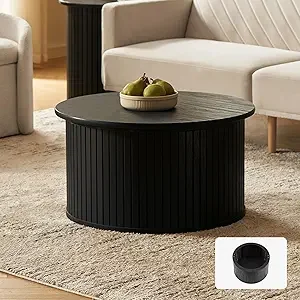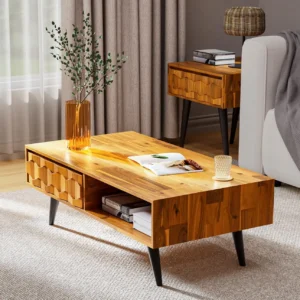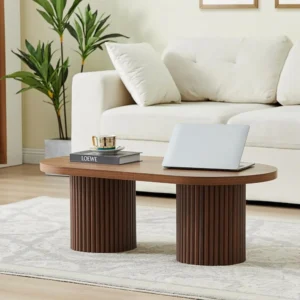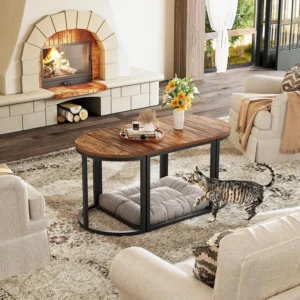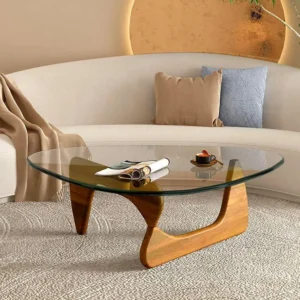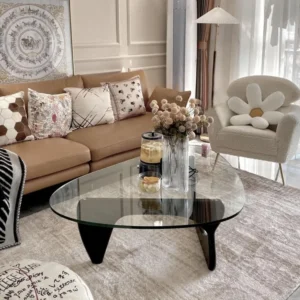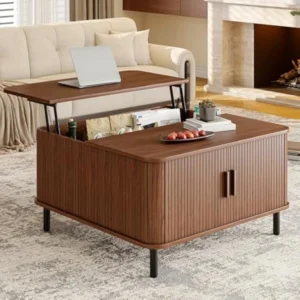Mid-century modern design continues to captivate homeowners and interior enthusiasts alike with its perfect balance of form and function. Emerging in the mid-20th century and experiencing a powerful resurgence in recent decades, this design movement celebrates clean lines, organic shapes, and a timeless approach to furniture. Within this beloved style, the black mid-century coffee table stands as a particularly striking centerpiece—one that brings sophistication and visual weight to living spaces while offering remarkable versatility across different interior aesthetics.
The appeal of black as a color choice for these iconic tables cannot be overstated. It enhances the table’s sculptural qualities, creates a powerful visual anchor in your living room, and infuses spaces with an understated elegance that feels both classic and contemporary. These pieces continue to be coveted in modern homes precisely because they transcend fleeting trends, offering enduring style that evolves beautifully with changing tastes.
In this article, we’ll explore the diverse world of intelligent black mid-century coffee tables through various design variations, styling approaches, and practical considerations. Whether you’re seeking to make a bold statement or create a subtle focal point, the versatility of black mid-century coffee tables offers endless possibilities for elevating your living space.
The Timeless Appeal of Black Mid-Century Coffee Tables
Black mid-century coffee tables hold a special place in interior design for their ability to enhance the core principles that make this style so enduring. The use of black elevates the clean lines and organic shapes that define mid-century design, creating a bold silhouette that draws attention to the table’s sculptural qualities. This color choice transforms what could be a simple functional piece into a sophisticated statement that grounds the entire room.
What makes these tables particularly valuable in interior design is their remarkable versatility. Black mid-century pieces possess a chameleon-like quality that allows them to:
- Create striking contrast in light, neutral spaces
- Add refined elegance to colorful, eclectic interiors
- Complement both warm and cool color palettes
- Bridge traditional and contemporary design elements
The psychological impact of black furniture is equally significant. Black creates visual weight and intentionality, suggesting sophistication and confidence in your design choices. It communicates drama without being overwhelming, especially when executed through the balanced proportions typical of mid-century design.
Perhaps most importantly, black mid-century coffee tables achieve the rare feat of feeling simultaneously vintage and current. They carry authentic historical design language while functioning as thoroughly modern pieces that can anchor contemporary interiors. This duality explains why the features of black mid-century coffee tables continue to resonate with both dedicated mid-century enthusiasts and those simply seeking quality, timeless furniture.
Essential Elements of Mid-Century Coffee Table Design
Understanding the defining characteristics of mid-century coffee tables helps you appreciate what makes these pieces special and recognize quality design when you see it. Authentic mid-century coffee table design is characterized by:
- Clean, uncluttered lines with an emphasis on horizontal planes and minimal ornamentation
- Organic and geometric forms that prioritize function while creating visual interest
- Intentional balance between form and practicality—these tables were designed to be used, not just admired
- Distinctive leg designs including tapered, splayed, and hairpin styles that create a sense of lightness
- Thoughtful proportions that often feature lower heights than contemporary coffee tables
In black mid-century coffee tables, these elements take on heightened prominence. The dark finish accentuates the silhouette, highlighting the elegant curves or sharp angles that define each piece. The contrast between solid black surfaces and the negative space created by distinctive leg designs becomes more dramatic, enhancing the table’s sculptural quality.
Quality craftsmanship in mid-century coffee tables reveals itself through precise joinery, thoughtful material selection, and attention to detail. In authentic vintage pieces or high-quality modern reproductions, you’ll find seamless connections, carefully finished edges, and balanced proportions. Modern reproductions of classic designs often maintain these quality standards while incorporating contemporary materials and manufacturing techniques.
For those interested in exploring beyond black finishes, our mid-century modern coffee tables collection offers a wider range of options that maintain these essential design principles across different materials and colors.
Materials That Define Black Mid-Century Coffee Tables
The materials used in black mid-century coffee tables contribute significantly to both their aesthetic appeal and functional durability. Traditional and contemporary options include:
- Ebonized or black-stained hardwoods: Walnut, oak, and teak were staples of mid-century furniture that, when treated with black stain or ebonized (a process that darkens wood without obscuring its grain), create rich, textural surfaces with subtle natural variations
- Black powder-coated or patinated metal: Used for legs, frames, and accents, these treatments provide durability while maintaining the sleek lines characteristic of mid-century design
- Smoked or black glass: Offers sophisticated transparency that lightens the visual weight of solid black tables while providing a reflective surface
- Black laminate or lacquer finishes: Provides a smooth, consistent surface often seen in more affordable mid-century pieces, offering excellent durability for everyday use
Material combinations are particularly important in mid-century design. The juxtaposition of different textures—such as a matte black wood frame with a glossy black glass top—creates visual interest within a monochromatic palette. Similarly, the contrast between black surfaces and visible wood grain or metal detailing adds depth to what might otherwise be a visually flat piece.
Durability considerations vary by material. Solid hardwoods with quality black finishes tend to be the most resistant to wear, developing character over time. Glass tops offer excellent resistance to stains but require regular cleaning to maintain their appearance. For those who prioritize longevity and natural materials, our solid wood coffee tables collection features pieces built to last generations while honoring mid-century design principles.
Design Variations: Exploring Black Mid-Century Coffee Table Shapes
The shape of a black mid-century coffee table significantly influences both its visual impact and functionality within your space. Each distinctive form offers unique benefits that can enhance different room layouts and aesthetic preferences.
Rectangular and square designs represent the most versatile and practical options in the mid-century repertoire. These angular tables provide maximum surface area for books, drinks, and decorative objects while creating a strong geometric presence that complements modern sectionals and traditional sofas alike. Black rectangular tables with crisp edges particularly excel at defining conversation areas in open floor plans, while their linear forms create pleasing parallel lines with surrounding furniture.
Round and oval tables introduce a softer element to living spaces with their flowing curves and absence of sharp corners. These shapes naturally encourage conversation by allowing people to gather around more intimately. In black finishes, round mid-century tables create dramatic circular silhouettes that feel both classic and contemporary. They’re particularly well-suited to smaller spaces where corners might impede movement, and their compact footprints make them ideal companions to apartment-sized sofas or loveseat arrangements. Our round and oval coffee table designs showcase how these shapes can transform different living spaces.
Organic and biomorphic shapes represent some of the most distinctive and artistically significant contributions of mid-century design. These free-form tables with kidney, amoeba, or abstract shapes make powerful statements in minimalist spaces where they can function as sculptural focal points. Black enhances the dramatic quality of these unique silhouettes, highlighting their artistic contours against neutral flooring or rugs.
Nesting and multi-tier tables showcase mid-century design’s ingenuity by offering adaptable functionality through movable or stacked components. Black finish unifies the separate elements while highlighting the clever spatial relationships between them. These space-efficient designs are particularly valuable in apartments or multipurpose rooms where flexibility matters as much as style.
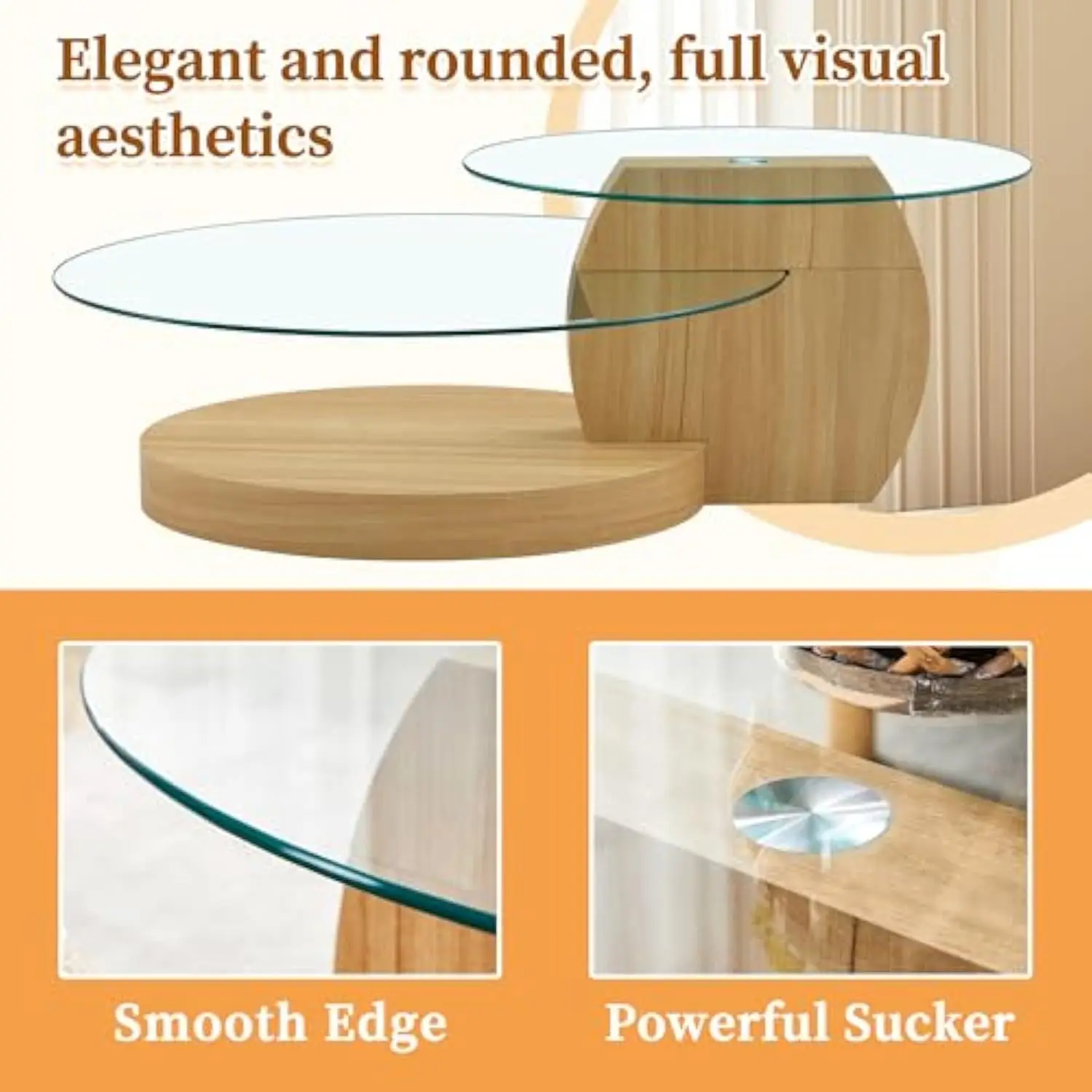
The black finish profoundly affects how we perceive each of these shapes. It emphasizes contours, creates stronger visual weight, and allows the eye to fully appreciate the intentional forms that make mid-century tables so distinctive. For those interested in styling black mid-century coffee tables, understanding these shape variations provides a foundation for making choices that complement your specific space and lifestyle needs.
Iconic Black Mid-Century Coffee Table Designs and Their Features
Mid-century coffee tables feature several distinctive design elements that have become iconic hallmarks of the style. Understanding these signature features helps you recognize quality designs and appreciate the thoughtfulness behind them:
Tapered legs represent perhaps the most quintessential mid-century silhouette. These legs begin wider at the top and narrow toward the floor, creating a sense of refined elegance and visual lightness. On black coffee tables, this tapering effect becomes particularly pronounced, drawing the eye along the graceful lines from surface to floor. This design element creates space beneath the table, making rooms feel less cluttered and more spacious.
Hairpin legs bring industrial influence to mid-century design with their minimalist bent wire construction. These slender metal supports provide remarkable structural strength while maintaining an airy, almost floating appearance. When paired with solid black table surfaces, hairpin legs create dramatic contrast that emphasizes both the substantial tabletop and the delicate supports beneath it.
Cantilever and pedestal designs showcase mid-century modernism’s playful relationship with gravity and structure. These designs appear to float or balance in ways that challenge visual expectations. Black finishes enhance this effect by creating strong silhouettes that highlight the engineering ingenuity behind these seemingly gravity-defying forms.
Integrated storage solutions demonstrate mid-century design’s commitment to functionality. Many coffee tables from this era feature clever drawers, shelves, or compartments that maintain clean lines while offering practical storage. In black finishes, these architectural details create subtle variations in tone and shadow that add visual richness to otherwise simple forms.
Mixed material compositions bring textural interest to black mid-century tables through thoughtful material combinations. Wood paired with glass, metal with stone, or various finishes within the same piece creates sophisticated visual harmony while honoring the era’s experimental spirit. For those interested in versatile options that maximize limited space, our nesting coffee tables collection features innovative designs that embody this mid-century principle of adaptable functionality.
Styling Your Black Mid-Century Coffee Table in Modern Interiors
A black mid-century coffee table serves as an anchor for your living space, creating a natural focal point around which to build your styling strategy. The key to successfully integrating these bold pieces lies in creating balance and intentionality throughout the room.
When styling the table itself, consider these proven approaches:
- Layer objects of varying heights to create visual interest without obstructing sightlines across the room
- Mix materials and textures to offset the solid black surface—incorporate warm woods, metallic accents, ceramic pieces, and natural elements
- Include functional items like beautiful books or decorative boxes that serve as conversation starters while providing remote storage
- Leave negative space on the table surface to prevent a cluttered appearance and maintain functionality
Complementary furniture choices significantly impact how your black coffee table is perceived in the space. Consider pairing with:
- Light-colored upholstery to create dramatic contrast that highlights the table’s strong silhouette
- Warm wood tones in side tables or consoles to echo mid-century materiality while softening the black finish
- Textural fabrics like bouclé, velvet, or woven upholstery that provide tactile contrast to the table’s smooth surface
Rug selection plays a crucial role in framing your coffee table arrangement. Light or medium-toned rugs with subtle patterns provide ideal backgrounds for black tables, while textured solid rugs create a sophisticated foundation. The rug should extend beyond the coffee table on all sides, ideally reaching under the front legs of surrounding seating to unify the conversation area.
Lighting deserves special consideration when working with black furniture. Directed lighting sources—like adjustable floor lamps or strategic accent lights—can highlight the sculptural qualities of your table, while ambient lighting ensures the black finish doesn’t absorb too much light from the room. For specific ideas tailored to black mid-century pieces, our guide to decorating black mid-century coffee tables offers detailed inspiration for various table shapes and room configurations.
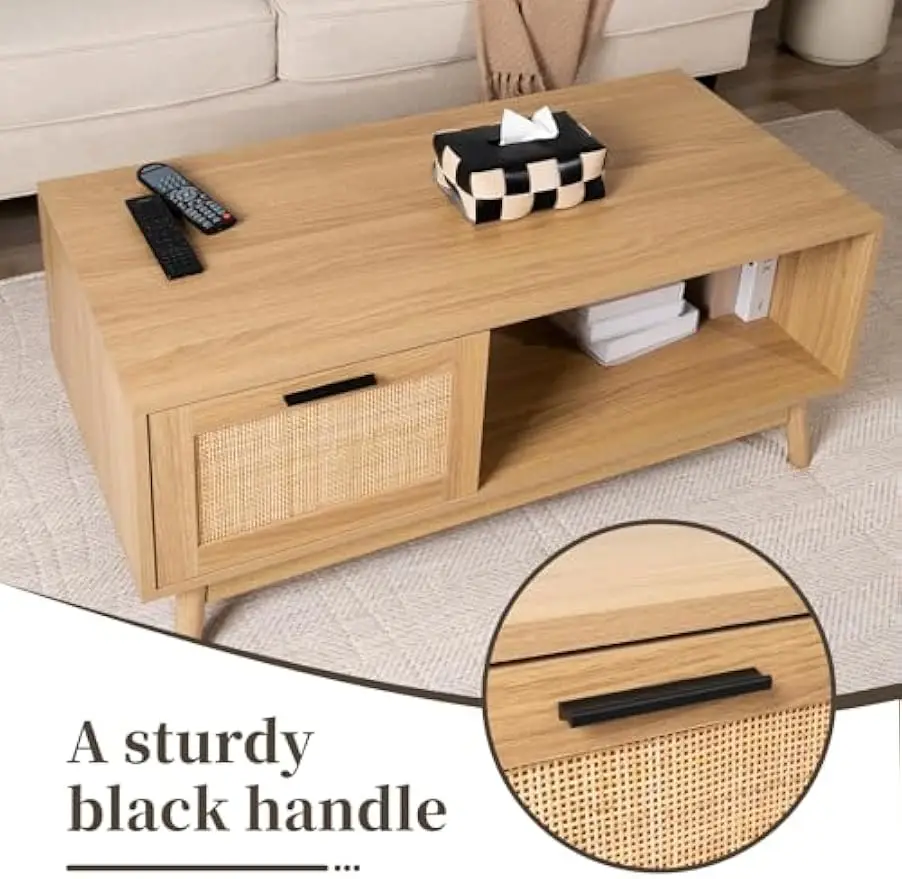
Creating the Perfect Coffee Table Vignette
Styling the surface of your black mid-century coffee table requires thoughtful attention to proportion, balance, and functionality. A well-designed coffee table vignette feels intentional rather than cluttered, offering visual interest while maintaining the table’s practical purpose.
Follow these principles to create harmonious arrangements:
- Work in odd numbers (especially groups of three) which naturally create more dynamic and visually appealing compositions
- Vary object heights to create rhythm and dimension—include at least one taller element, one medium-height piece, and one lower profile item
- Layer different sizes and shapes to create depth—rectangular books beneath round objects, for example
- Incorporate contrasting textures such as smooth ceramics, rough natural elements, and glossy art books to offset the table’s smooth surface
- Add one organic element like a small plant, fresh flowers, or an interesting piece of driftwood to bring life to the arrangement
For rectangular tables, consider dividing the surface into sections—perhaps using a tray to define one area for decorative objects while leaving another clear for practical use. On round tables, centering a main decorative element and building outward in a roughly triangular pattern often creates the most pleasing arrangement.
Practical considerations should always guide your styling choices. Families with young children might prioritize sturdier, less precious items, while frequent entertainers might create flexible arrangements that can be easily adjusted to accommodate snacks and drinks. Seasonal refreshes can be as simple as switching out a few decorative objects or books to reflect changing colors and textures throughout the year.
The black surface of your mid-century coffee table provides an excellent canvas for highlighting the colors and textures of your decorative objects. Light-colored items and metallic accents particularly stand out against the dark background, creating dramatic focal points within your arrangement. Those interested in round table options can explore our round coffee tables collection for pieces that offer elegant proportions for creating balanced vignettes.
Color Schemes That Enhance Black Mid-Century Coffee Tables
The color palette you choose for your living space dramatically influences how your black mid-century coffee table is perceived. Strategic color choices can enhance its presence, create meaningful contrast, or help it blend seamlessly into a cohesive design scheme.
Monochromatic schemes using various shades of black, charcoal, gray, and white create sophisticated, contemporary environments where your black coffee table feels like a natural extension of the design language. This approach works particularly well in modern spaces with architectural interest, as the limited palette allows structural elements and furniture silhouettes to take center stage. Introduce textural variation through different materials and finishes to prevent the space from feeling flat.
Warm neutrals including creams, tans, caramels, and browns offer beautiful contrast to black furniture while maintaining an inviting, livable atmosphere. This palette honors mid-century modern’s connection to natural materials and earthy tones. The black coffee table provides a strong anchor point amid these softer hues, creating visual balance through contrast. Layering different wood tones throughout the space adds rich dimensional quality that feels both current and timeless.
Bold color accents strategically paired with neutral backgrounds allow your black coffee table to serve as a sophisticated bridge between vibrant elements. Traditional mid-century colors like mustard yellow, burnt orange, teal blue, or emerald green can be incorporated through accent pillows, artwork, or a signature upholstered piece. The black table helps ground these bolder choices, preventing the space from feeling overwhelming.
Natural palettes featuring the browns and greens found in plants, natural fibers, and wood tones create organic, balanced environments where black acts as a contemporary counterpoint. This approach works beautifully in spaces with ample natural light and connections to outdoor views. Consider incorporating abundant plant life, natural wood tones, and textural elements like sisal, jute, or wool to create a harmonious backdrop for your black coffee table.
When selecting your color scheme, consider how light interacts with your space throughout the day. Rooms with limited natural light often benefit from lighter wall colors and strategic lighting to prevent the black table from feeling too heavy. For more guidance on integrating these pieces into various interior styles, our article on black coffee tables in mid-century interiors provides detailed color recommendations for different aesthetic approaches.
Pairing Furniture with Your Black Mid-Century Coffee Table
Creating harmony between your black mid-century coffee table and surrounding furniture requires thoughtful consideration of styles, proportions, and finishes. The table often serves as a foundational piece that can guide other selections throughout the room.
When selecting seating to complement your coffee table, consider these options:
- Low-profile sofas with clean lines and minimal detailing create cohesive mid-century groupings
- Light-colored upholstery provides dramatic contrast that highlights the table’s dark finish
- Textured fabrics like bouclé, tweed, or velvet add tactile interest against the smooth table surface
- Sculptural chairs with distinctive silhouettes create visual conversation with the table’s own design language
For side tables and accent furniture, you have several approaches:
- Matching black finishes create sophisticated monochromatic continuity
- Contrasting warm woods like walnut, teak, or oak add warmth and authentic mid-century appeal
- Metal accents in brass, copper, or chrome introduce reflective elements that catch light
- Glass or acrylic pieces add visual lightness to balance the substantialness of the black coffee table
Scale and proportion demand particular attention when working with a black coffee table. Since dark colors can sometimes appear more visually dominant, ensure that surrounding furniture maintains appropriate scale relationships. Your coffee table should generally be about two-thirds the length of your sofa, with a height equal to or slightly lower than your sofa seat height for comfortable use.
Material coordination doesn’t require exact matching but should demonstrate intentional relationship. Consider selecting one or two additional black elements elsewhere in the room—perhaps lamp bases, picture frames, or decorative objects—to create purposeful connection with your coffee table. For those exploring different wood finishes that pair well with black, our walnut coffee table designs showcase beautiful options that complement black accents through rich, warm tones.
Black Mid-Century Coffee Tables in Different Interior Styles
The versatility of black mid-century coffee tables allows them to enhance various interior styles, each highlighting different aspects of these iconic pieces. Understanding how these tables function across design approaches helps you integrate them seamlessly into your preferred aesthetic.
Modern Minimalist spaces celebrate the clean lines and purposeful design of black mid-century coffee tables. In these uncluttered environments, the table often serves as a sculptural focal point against neutral backgrounds. Its simple geometry complements the minimalist ethos while adding necessary visual weight and anchoring the space. Style these tables with just a few carefully chosen objects—perhaps a single art book, a striking ceramic piece, and a small plant—to maintain the clean aesthetic while adding personality.
Eclectic Interiors benefit from the grounding presence black mid-century coffee tables provide amid diverse styles and periods. These tables offer a sophisticated constant around which more playful or unexpected elements can orbit. Their classic forms provide visual stability while their black finish creates cohesion among varied colors and textures. In eclectic spaces, style these tables more generously with collected objects that tell your personal story—vintage finds, travel souvenirs, and contemporary art pieces can coexist harmoniously atop these versatile surfaces.
Industrial Settings find natural companionship with black mid-century coffee tables, particularly those featuring metal components or glass tops. The table’s refined lines offer welcome contrast to industrial spaces’ rougher textures and utilitarian elements. Black finishes complement exposed brick, raw concrete, and metal fixtures while adding a layer of intentional sophistication. In these contexts, the coffee table often benefits from simpler styling—perhaps a stack of architecture books or a sculptural metal object—that echoes the straightforward, functional ethos of both industrial and mid-century design.
Scandinavian-Inspired Spaces create beautiful tension between light and dark elements when incorporating black mid-century coffee tables. Against the typical Scandinavian palette of whites, light woods, and soft neutrals, the black table provides decisive contrast and visual anchor. Style these tables with natural materials like wooden bowls, ceramic vessels, and woolen textiles to bridge the mid-century and Scandinavian aesthetics. The result feels both cozy and sophisticated, honoring both design traditions.
Maximalist Interiors use black mid-century coffee tables as grounding elements amid bold colors, patterns, and collected treasures. The table’s simple form and solid color create a visual resting place within more elaborate surroundings. In maximalist spaces, the coffee table often becomes a curated display surface for favorite objects, stacked books, and conversation pieces. The disciplined design language of mid-century modernism provides welcome structure within the creative abundance of maximalist style.
For those interested in exploring various table designs that suit these different interior approaches, our guide to black mid-century modern coffee table styles offers detailed recommendations for specific aesthetic goals.
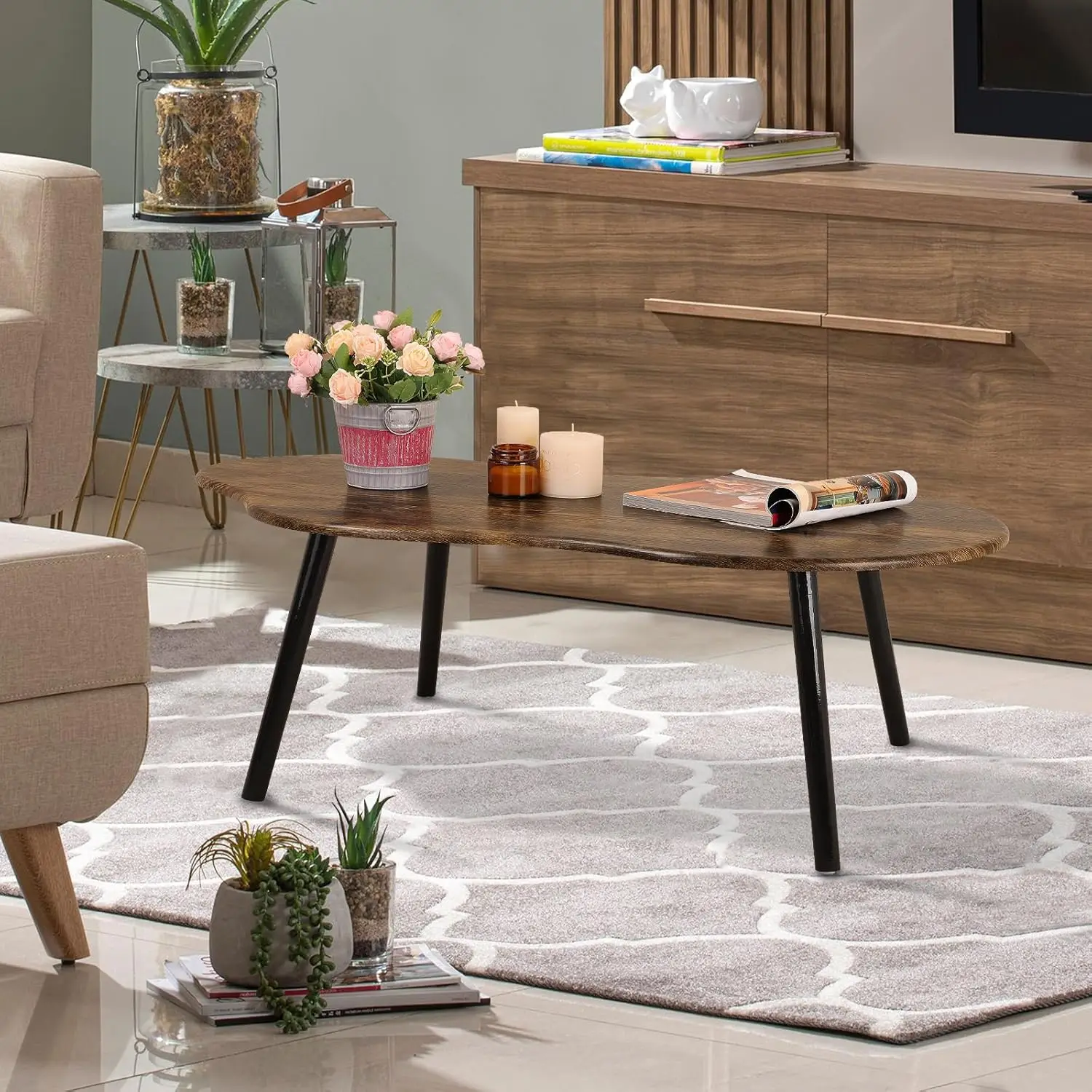
Practical Considerations: Size, Placement, and Functionality
Beyond aesthetics, successful integration of a black mid-century coffee table requires careful attention to practical matters of size, placement, and everyday functionality. These considerations ensure your stylish piece also serves your lifestyle needs effectively.
When determining the appropriate size for your coffee table, follow these general guidelines:
- Length: Ideally 1/2 to 2/3 the length of your sofa for balanced proportions
- Height: Even with or up to 2 inches lower than your sofa seat height for comfortable use
- Clearance: Maintain 14-18 inches between the table and surrounding seating for easy movement
- Walking paths: Ensure at least 30 inches of clear space in traffic lanes around the table
Optimal placement centers the coffee table within your seating arrangement, typically positioned:
– Centered in front of the sofa in traditional arrangements
– Centered within the “U” of a sectional configuration
– Equidistant from all seats in a conversational grouping
Traffic flow considerations are particularly important with larger black coffee tables, which can appear more visually substantial than lighter-colored pieces. Ensure your table doesn’t obstruct natural pathways through the room, and consider how people move when entering and exiting the seating area. Round or oval tables often provide better flow in tighter spaces by eliminating sharp corners.
Functionality needs vary by household, but most require a coffee table to serve multiple purposes:
- Surface area for beverages, books, remote controls, and decorative objects
- Storage potential through drawers, shelves, or lift-tops for hiding clutter
- Durability appropriate to household activities (consider children, pets, and entertaining habits)
- Material practicality that aligns with maintenance preferences and lifestyle needs
Black finishes require specific care considerations. Wood tables with black stains or paints may show dust more readily than natural wood finishes, while black glass surfaces often show fingerprints. Consider your tolerance for regular maintenance when selecting materials and finishes. For more information on maximizing functionality in smaller spaces, our guide to maximizing black mid-century coffee tables offers practical solutions for various living situations.
Mid-Century Modern Solid Wood Coffee Tables, Mid-Century Modern Teak Coffee Tables
$879.95 Select options This product has multiple variants. The options may be chosen on the product pageMid-Century Modern Danish Coffee Tables, Mid-Century Modern Oval Coffee Tables, Mid-Century Modern Solid Wood Coffee Tables
$390.05 Select options This product has multiple variants. The options may be chosen on the product pageMid-Century Modern Coffee & End Table Sets, Mid-Century Modern Coffee Table Sets, Mid-Century Modern Oval Coffee Tables
Price range: $257.48 through $331.04 Select options This product has multiple variants. The options may be chosen on the product pageMid-Century Modern Glass Top Coffee Tables, Mid-Century Modern Glass Top Side & End Tables
$460.58 Select options This product has multiple variants. The options may be chosen on the product pageMid-Century Modern Glass Top Coffee Tables, Mid-Century Modern Vintage Coffee Tables, Mid-Century Modern Vintage Side & End Tables
$725.36 Select options This product has multiple variants. The options may be chosen on the product pageMid-Century Modern Lift Top Coffee Tables, Mid-Century Modern Square Coffee Tables
$454.73 Select options This product has multiple variants. The options may be chosen on the product page
Is a Black Mid-Century Coffee Table Right for Your Space?
Deciding whether a black mid-century coffee table suits your specific living situation requires honest evaluation of several practical factors:
Will a black table make my small space feel smaller?
Not necessarily. While dark colors can sometimes visually recede, the open, elevated designs common to mid-century pieces often create a sense of spaciousness beneath the table surface. Tables with glass components or slender legs can feel particularly light. In small spaces, consider round tables or nesting designs that offer flexibility and improved traffic flow.
How does a black table work in rooms with limited natural light?
Rooms with minimal natural light can still successfully incorporate black coffee tables when balanced with appropriate lighting and lighter surrounding elements. Position table lamps strategically to illuminate the table’s surface, choose lighter upholstery for adjacent seating, and consider reflective elements like mirrors or metallic accents to enhance available light.
Is a black coffee table practical for families with children?
Black tables can actually be quite family-friendly, as they tend to hide minor scratches and marks better than lighter finishes. Look for tables with rounded corners if you have young children, and consider durable materials like hardwoods with quality finishes or tempered glass. Tables with storage components offer the added benefit of quick cleanup options for toys and games.
How versatile are black mid-century pieces if I change my decor?
Black mid-century coffee tables rank among the most adaptable furniture pieces because their neutral color and classic design transcend trends. These tables can transition seamlessly through various color schemes and style evolutions in your home. Their architectural quality and neutral palette allow them to serve as constants while other elements around them change.
What maintenance challenges are specific to black furniture?
Black surfaces, particularly glossy ones, can show dust and fingerprints more readily than other finishes. Regular dusting with a microfiber cloth helps maintain their appearance, while occasional polishing with appropriate products preserves their finish. Tables combining black with other materials may require specific care for each component. For those considering rectangular options with practical proportions, our rectangular coffee tables collection features designs that balance style with everyday functionality.
Where to Find Quality Black Mid-Century Coffee Tables
Sourcing the perfect black mid-century coffee table requires knowing where to look and understanding how to evaluate quality across different price points and sources. The market offers several distinct shopping categories, each with unique advantages:
Specialty furniture retailers focusing on mid-century design offer curated selections of both authentic vintage pieces and high-quality reproductions. These sources typically provide the most accurate interpretations of classic designs with appropriate materials and proportions. Their expertise often translates to higher prices, but also ensures design authenticity and construction quality that justifies the investment.
Online marketplaces have dramatically expanded access to both vintage and reproduction mid-century pieces. When shopping these platforms, look for detailed photos showing construction details, clear descriptions of materials, and seller policies regarding returns. For vintage pieces, request additional images of joints, undersides, and any maker’s marks to verify authenticity and condition.
Vintage and antique shops offer the thrill of discovering authentic period pieces with unique character and history. When evaluating vintage black mid-century coffee tables, examine:
– Construction quality through solid joinery and hardware
– Material authenticity appropriate to the era
– Signs of professional restoration versus amateur repairs
– The difference between natural patina (desirable) and damage (concerning)
When assessing quality in any setting, prioritize these indicators:
- Solid wood construction in structural components
- Smooth, even finishes without bubbling or inconsistencies
- Precise joinery with tight, even connections
- Appropriate weight that suggests substantial materials
- Consistent design language true to mid-century principles
Understanding price ranges helps set realistic expectations. Entry-level reproductions start around $200-300, quality mid-range pieces typically fall between $500-1200, while authentic vintage or premium reproduction pieces can range from $1200 to several thousand dollars depending on designer, condition, and rarity.
When shopping online, useful search terms include “authentic mid-century coffee table,” “Danish modern black coffee table,” “ebonized wood mid-century table,” or specific designers like “Nelson,” “Noguchi,” or “Eames” for iconic styles. For those seeking guidance on top-rated options, our best black mid-century coffee tables guide provides detailed recommendations across various styles and price points.
Maintaining the Beauty of Your Black Mid-Century Coffee Table
Proper care ensures your black mid-century coffee table remains a stunning centerpiece for years to come. Different materials require specific maintenance approaches:
Wood with black finishes (stained, painted, or ebonized):
– Dust regularly with a soft, lint-free cloth to prevent particle buildup
– Clean with a slightly damp cloth and mild soap solution when needed, drying immediately
– Apply furniture wax specifically formulated for dark finishes twice yearly to maintain luster
– Use coasters and placemats to prevent water rings and heat damage
– Address scratches promptly with appropriate touch-up products for black finishes
Metal components:
– Wipe regularly with a soft cloth to remove fingerprints and dust
– Clean chrome or stainless steel with appropriate metal cleaners
– Treat brass or copper elements with specific metal polishes to maintain patina
– Check and tighten hardware periodically to maintain structural integrity
Glass surfaces:
– Clean with quality glass cleaner and microfiber cloths to prevent streaking
– Use felt pads under objects placed directly on glass
– Inspect regularly for chips or cracks, especially along edges
– Consider glass-specific protective treatments for high-traffic homes
Laminates and manufactured materials:
– Wipe with slightly damp microfiber cloth for regular cleaning
– Use gentle cleaners formulated for synthetic surfaces
– Avoid abrasive cleaners or scrubbing pads that can damage the finish
– Protect from direct sunlight which can fade black finishes over time
Common issues with black finishes include dust visibility, fingerprints, and minor scratches that appear lighter against the dark background. Address these promptly with appropriate cleaning and touch-up products. For black wood surfaces, specialized furniture markers, fill sticks, or touch-up kits in exact color matches can disguise minor damage.
Preventative measures significantly extend your table’s beauty:
– Use coasters for all beverages
– Place protective pads under hot items
– Apply felt dots to the bottoms of decorative objects
– Consider glass tops for valuable vintage pieces that see heavy use
– Position tables away from direct sunlight to prevent fading
With proper care, a quality black mid-century coffee table will continue to be a stunning focal point in your home for generations, developing character and patina that only enhance its appeal over time.

